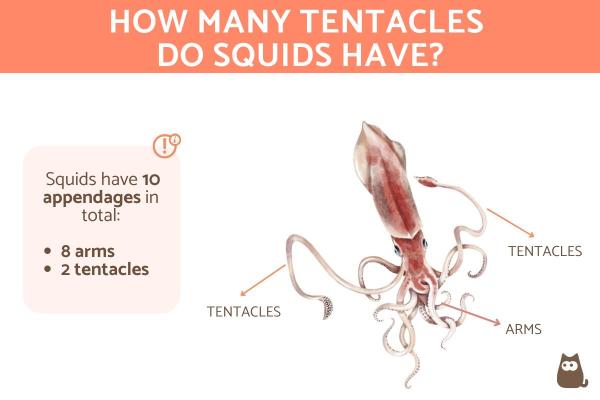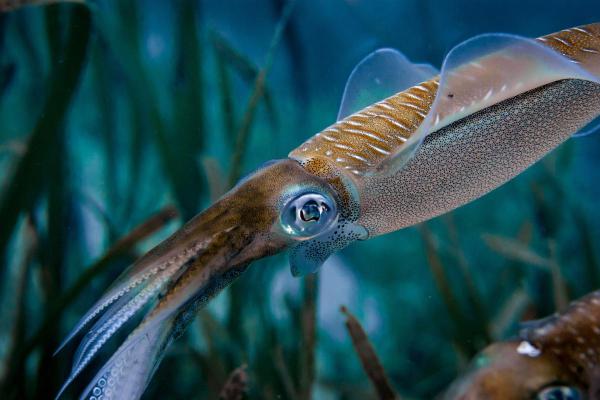
A common misconception about squids is that all their appendages are tentacles. Squids actually have only two tentacles and eight arms. This distinction, while seemingly minor, highlights a key aspect of their specialized hunting adaptations. Tentacles and arms have unique purposes, with distinct structures and functions.
This AnimalWised article explores the question of how many tentacles do squids have, how they use them, and how these vary across different species.
How many tentacles does a squid have?
Squids have ten appendages: eight arms and two tentacles, each with different roles.
The arms, lined with rows of suckers, provide strength and flexibility. They work independently, allowing the squid to swim, capture prey, and handle food. Each arm contains muscles that enable precise movement and control.
The tentacles are longer than the arms and end in specialized clubs equipped with suckers or hooks. These tentacles can shoot out and pull back rapidly, like fishing rods. When not hunting, the squid stores them in special pouches within its body.
During hunting, the squid extends its tentacles to catch prey from a distance. Once caught, the prey is transferred to the arms, which guide it to the squid's beak for eating. This two-step process makes squids effective hunters.
The ratio of arm to tentacle length varies among squid species. Deep-sea squids often have very long tentacles, while in other species, the tentacles are only slightly longer than the arms.
Why are the tentacles longer than the arms?
The length of a squid's tentacles is key to its hunting strategy. While the arms stay close to the body for swimming and handling food, the tentacles need to reach far out to catch prey. This extra length lets the squid catch food from a safe distance, reducing risk of injury. Long tentacles also help catch fast-moving prey that swim beyond arm's reach, as they can extend quickly and grab targets before they escape.
How do squid tentacles work?
Tentacles extend using a specialized hydrostatic system, where muscle contractions and fluid pressure work together like a hydraulic spring. This unique mechanism can generate forces exceeding 100 times the squid's body weight.
The strike happens in less than 50 milliseconds, which is faster than a human can blink. The tentacle clubs are equipped with up to 400 suckers, each containing sensory receptors that help detect prey. In some species, these suckers are ringed with sharp chitin that can pierce prey while gripping.
The capture sequence shows remarkable precision. As tentacles strike, they also rotate to optimize sucker contact. Special nerve clusters in the tentacles allow instant adjustments during the strike, even before signals reach the brain. The arms then take over, using different types of suckers, some for gripping, others for tasting the prey.
This combination of speed, strength, and sensory control makes squid tentacles among the most sophisticated predatory tools in the ocean. A single failed strike can cost valuable energy, so this precision is essential for survival.

What is the difference between an oral arm and a tentacle?
While both arms and tentacles are muscular appendages, they differ significantly in their structure and specialization. Let us take a closer look at some of these differences:
- Arms contain uniform muscle fibers arranged in a simple pattern, while tentacles have three distinct muscle types organized in complex layers that enable explosive extension.
- Arm suckers are evenly spaced along the entire length and contain basic gripping muscles. In contrast, tentacle suckers are concentrated only on the club and have additional sensory cells that help detect prey. These club suckers are often larger and more specialized than arm suckers, with some species developing them into hooks.
- Arms have a relatively rigid core that maintains their shape, while tentacles contain elastic collagen fibers that allow them to stretch to several times their relaxed length without damage. This flexibility lets tentacles shoot out rapidly during hunting.
- Arms have a simple nerve cord, but tentacles possess giant nerve fibers and specialized control centers that enable faster responses. These neural adaptations, combined with their unique muscle structure, make tentacles highly effective for striking at distant prey while arms excel at close-range manipulation.
Did you know there are over 300 known species of squid? Learn about the most fascinating ones in our other article.

Evolution and diversity of squid tentacles
Modern squid tentacles evolved from simpler arm-like appendages over millions of years. Early cephalopods had ten similar arms, but gradually two of these arms lengthened and developed specialized tips. This adaptation first appeared in ancient squid ancestors about 150 million years ago, giving them an advantage in catching prey from a distance.
Tentacle structure varies significantly across today's squid species. Coastal squids typically have shorter, more muscular tentacles with simple suckers for catching fish and crustaceans. In contrast, deep-sea squids show more specialized adaptations. The Humboldt squid (Dosidicus gigas), for example, has developed sharp hooks on its clubs for gripping slippery fish, while the glass squid has tentacles so transparent they're nearly invisible to prey.
Deep-sea species show particularly striking adaptations. Many have extremely long, thin tentacles that can stretch up to eight times their relaxed length, far more than their shallow-water relatives. These tentacles often feature bioluminescent organs that can flash to attract prey. Some deep-sea squids have even lost their tentacles entirely, relying instead on modified arms for catching prey.
Ever wondered how deep-sea creatures illuminate the darkness? Learn about nature's living light bulbs in our article about bioluminescent animals.
If you want to read similar articles to How Many Tentacles Do Squids Have?, we recommend you visit our Facts about the animal kingdom category.
Kier, W. M. (1982). The functional morphology of the musculature of squid (Loliginidae) arms and tentacles. Journal of Morphology, 172(2), 179-192.
Kier, W. M. (1985). The musculature of squid arms and tentacles: ultrastructural evidence for functional differences. Journal of Morphology, 185(2), 223-239.
Van Leeuwen, J.L., & Kier, W.M. (1997). Functional design of tentacles in squid: linking sarcomere ultrastructure to gross morphological dynamics. Philosophical Transactions of the Royal Society of London. Series B: Biological Sciences, 352(1353), 551-571.
Vidal, EA, & Salvador, B. (2019). The tentacular strike behavior in squid: Functional interdependency of morphology and predatory behaviors during ontogeny. Frontiers in Physiology, 10, 1558.